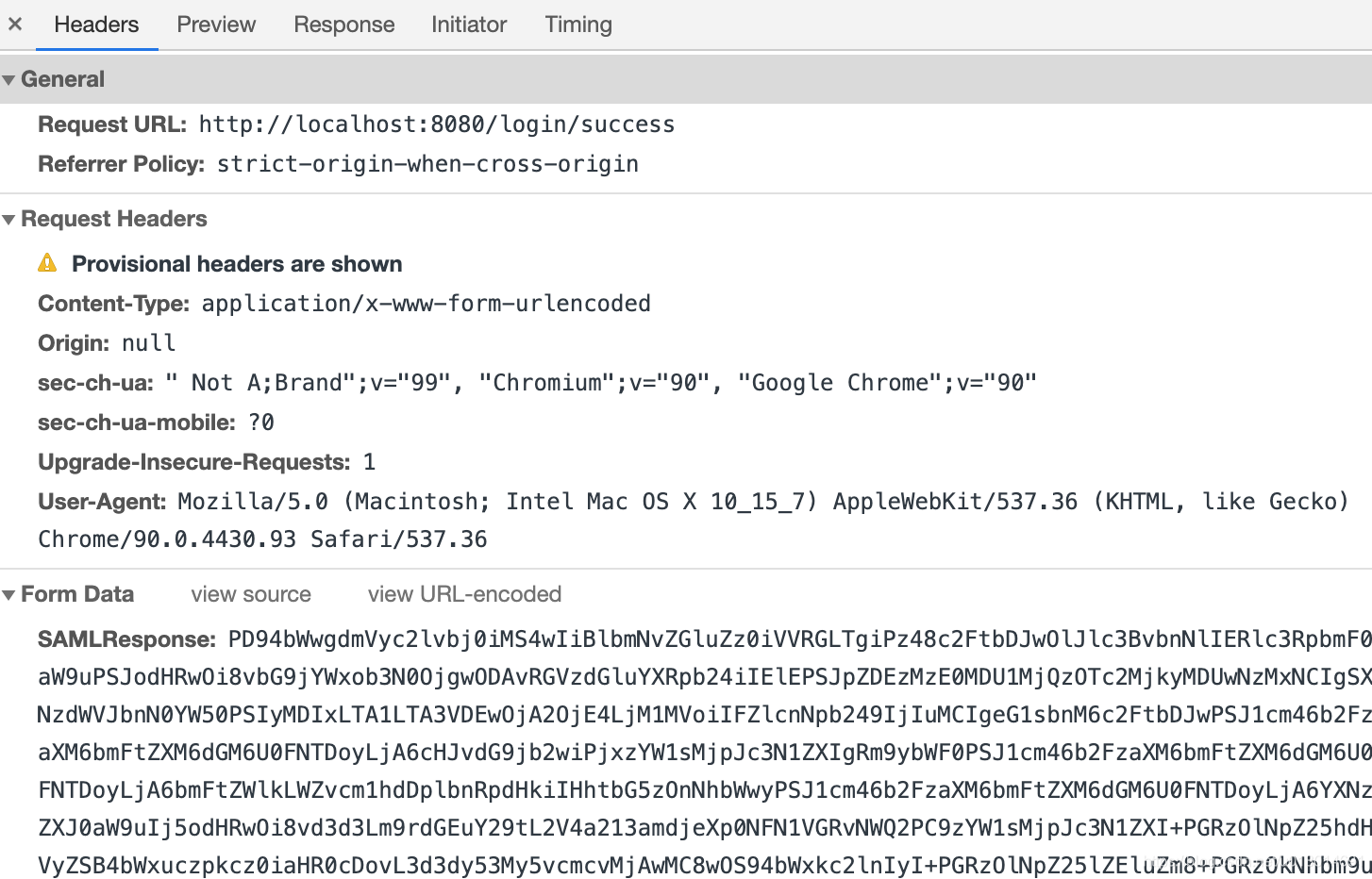对接OKTA 使用SAML2.0协议
缘起
给客户做项目,客户要求内部使用okta登陆,使用SAML2.0协议,需要对接。
okta初探
OKTA是SSO,有个网站可以让我们测试,地址:okta developer,SAML协议的交互流程大致如下
浏览器打开需要登录系统登陆界面,系统登陆界面只有一个登陆按钮,没有输入用户名密码的地方(原因是OKTA使用域账户登陆的时候,能直接获取域账户名,除了这个还有好多客户端都支持,比如Apple账户)
点击按钮,跳转到OKTA页面,这个页面只有一个loading动画,个人猜测里面有获取当前域账户名的代码
然后再次一个跳转,这个跳转跳到一个回调url,这个url官方名称为
Single Sign On URL,记住它,后面会用到。跳转到这个页面后,浏览器会发送一个POST请求,content-type是application/x-www-form-urlencoded,参数包含一个SAMLResponse和RelayState(这个是在OKTA控制台配置的回传参数)大概的样子是
第3步中的
SAMLResponse就是一个xml文档的base64编码后的数据,回调地址接收到SAMLResponse进行校验,并获取登陆名OKTA的配置
Single Sign On URL配置我们的系统的地址,是OKTA将认证完成后告诉我们结果的一个接口,接收参数是SAMLResponse和RelayState,格式是application/x-www-form-urlencoded,java中方法签名大概是:@RequestMapping(value = "/login/success",method = {RequestMethod.POST}) public String loginSuccess(String SAMLResponse, String RelayState){ System.out.println("sAMLResponse:"+SAMLResponse); System.out.println("RelayState:" + RelayState); return "success"; }配置的地方如下:

全部配置完后会得到一个页面大致如下
 注意:
注意:Identity Provider Single Sign-On URL这个就是上面第一步中点击按钮跳转到的链接X.509 Certificate这部分是公钥,用来验证SAMLResponse中签名的公钥这个页面可以让你上传一个csv文件(包含登陆名信息)加入到你的group里面,登陆是否能成功,就是取你的域账户名,查询是否在你的group里面,当然你可以配置更复杂的规则

验证逻辑
- 引入jar包:
<dependency> <groupId>org.opensaml</groupId> <artifactId>opensaml</artifactId> <version>2.6.4</version> </dependency> - 验证逻辑:
import org.joda.time.DateTime; import org.joda.time.DateTimeZone; import org.opensaml.Configuration; import org.opensaml.DefaultBootstrap; import org.opensaml.saml2.core.Assertion; import org.opensaml.saml2.core.Response; import org.opensaml.xml.ConfigurationException; import org.opensaml.xml.XMLObject; import org.opensaml.xml.io.Unmarshaller; import org.opensaml.xml.io.UnmarshallerFactory; import org.opensaml.xml.io.UnmarshallingException; import org.opensaml.xml.security.x509.BasicX509Credential; import org.opensaml.xml.signature.Signature; import org.opensaml.xml.signature.SignatureValidator; import org.opensaml.xml.util.Base64; import org.opensaml.xml.validation.ValidationException; import org.slf4j.Logger; import org.slf4j.LoggerFactory; import org.w3c.dom.Document; import org.w3c.dom.Element; import org.xml.sax.SAXException;
import javax.xml.parsers.DocumentBuilder; import javax.xml.parsers.DocumentBuilderFactory; import javax.xml.parsers.ParserConfigurationException; import java.io.ByteArrayInputStream; import java.io.IOException; import java.security.KeyFactory; import java.security.NoSuchAlgorithmException; import java.security.PublicKey; import java.security.cert.CertificateException; import java.security.cert.CertificateFactory; import java.security.cert.X509Certificate; import java.security.spec.InvalidKeySpecException; import java.security.spec.X509EncodedKeySpec;
public class Test {
private static final Logger logger = LoggerFactory.getLogger(Test.class);
private static final String pattern = "yyyy-MM-dd HH:mm:ss";
private static final BasicX509Credential credential = new BasicX509Credential();
//X.509 Certificate
public static final String publicKeyStr = "xxxxxxx";
//responseMsg就是SAMLResponse
public String validate(String responseMsg) {
ByteArrayInputStream byteArrayInputStream = null;
try {
CertificateFactory certificateFactory = CertificateFactory.getInstance("X.509");
byteArrayInputStream = new ByteArrayInputStream(Base64.decode(publicKeyStr));
X509Certificate certificate = (X509Certificate) certificateFactory.generateCertificate(byteArrayInputStream);
KeyFactory keyFactory = KeyFactory.getInstance("RSA");
X509EncodedKeySpec publicKeySpec = new X509EncodedKeySpec(certificate.getPublicKey().getEncoded());
PublicKey publicKey = keyFactory.generatePublic(publicKeySpec);
credential.setPublicKey(publicKey);
} catch (CertificateException e) {
logger.error("加载okta PublicKey失败", e);
} catch (NoSuchAlgorithmException e) {
logger.error("加载okta PublicKey失败", e);
} catch (InvalidKeySpecException e) {
logger.error("加载okta PublicKey失败", e);
}finally {
if(byteArrayInputStream != null){
try {
byteArrayInputStream.close();
} catch (IOException e) {
e.printStackTrace();
}
}
}
try (ByteArrayInputStream inputStream = new ByteArrayInputStream(Base64.decode(responseMsg))) {
DefaultBootstrap.bootstrap();
DocumentBuilderFactory documentBuilderFactory = DocumentBuilderFactory.newInstance();
documentBuilderFactory.setNamespaceAware(true);
DocumentBuilder documentBuilder = documentBuilderFactory.newDocumentBuilder();
Document document = documentBuilder.parse(inputStream);
Element documentElement = document.getDocumentElement();
UnmarshallerFactory unmarshallerFactory = Configuration.getUnmarshallerFactory();
Unmarshaller unmarshaller = unmarshallerFactory.getUnmarshaller(documentElement);
XMLObject xmlObject = unmarshaller.unmarshall(documentElement);
Response response = (Response) xmlObject;
Assertion assertion = response.getAssertions().get(0);
//验证签名
Signature signature = assertion.getSignature();
SignatureValidator signatureValidator = new SignatureValidator(credential);
//签名验证失败会抛错
signatureValidator.validate(signature);
//校验是否登录成功
String successStr = response.getStatus().getStatusCode().getValue();
if (!successStr.contains("Success")) {
logger.error("登录成功标志校验失败,successStr={}", response.getStatus().getStatusCode().getValue());
return null;
}
//检验登录时间
DateTime notBefore = assertion.getConditions().getNotBefore();
DateTime notOnOrAfter = assertion.getConditions().getNotOnOrAfter();
DateTime now = new DateTime(DateTimeZone.UTC);
logger.error("验证okta返回的时间,notBefore={},notOnOrAfter={},now={}",
notBefore.toString(pattern), notOnOrAfter.toString(pattern), now.toString(pattern));
if (now.isBefore(notBefore) || now.isAfter(notOnOrAfter)) {
logger.error("登录成功时间校验失败,notBefore={},notOnOrAfter={},now={}",
notBefore.toString(pattern), notOnOrAfter.toString(pattern), now.toString(pattern));
return null;
}
//返回登录用户名
return assertion.getSubject().getNameID().getValue();
} catch (IOException e) {
logger.error("验证SAMLResponse失败", e);
} catch (ParserConfigurationException e) {
logger.error("验证SAMLResponse失败", e);
} catch (SAXException e) {
logger.error("验证SAMLResponse失败", e);
} catch (UnmarshallingException e) {
logger.error("验证SAMLResponse失败", e);
} catch (ValidationException e) {
logger.error("验证SAMLResponse失败", e);
} catch (ConfigurationException e) {
logger.error("验证SAMLResponse失败", e);
} catch (Exception ex) {
logger.error("验证SAMLResponse失败", ex);
}
return null;
}} ```









